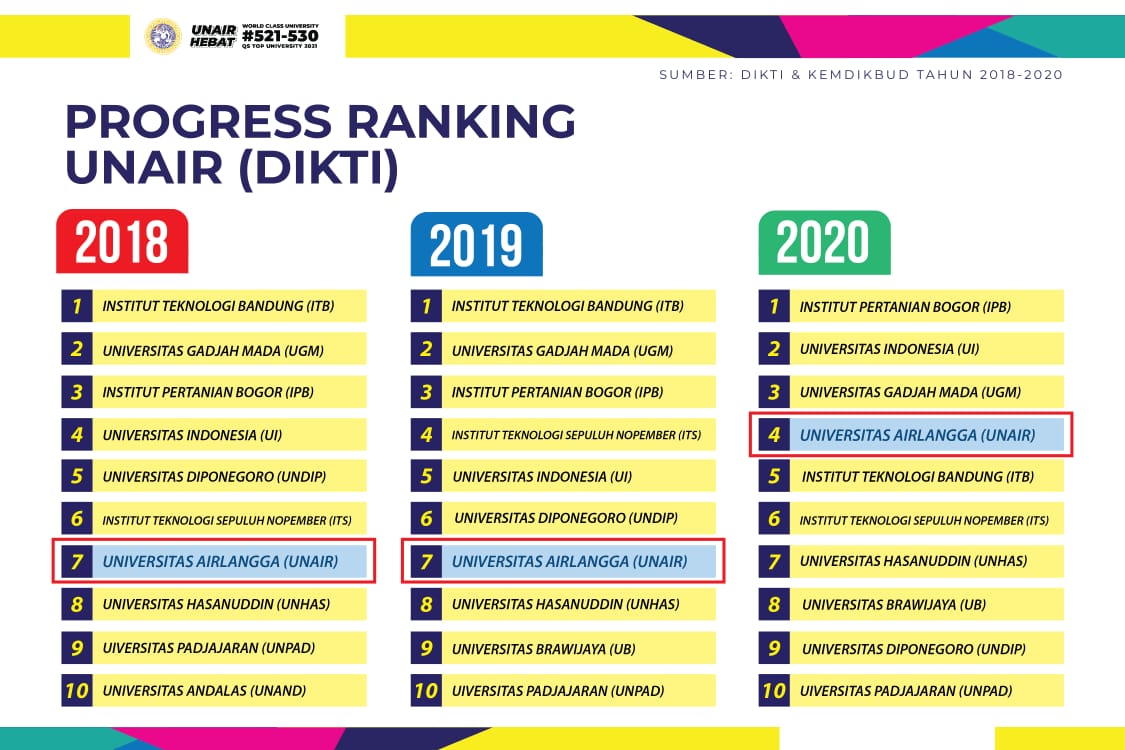UNAIR NEWS – Based on the cluster 1 higher education ranking by the Ministry of Education and Culture (Kemendikbud) in 2020, Universitas Airlangga is in fourth place.
In the ranking, Universitas Airlangga is cluster 1 ranking with a score of 3,299. UNAIR is ranked fourth in Indonesia after IPB University (IPB), University of Indonesia (UI), and Gadjah Mada University (UGM).
Followed by Bandung Institute of Technology (ITB), Sepuluh November Institute of Technology (ITS), Hasanuddin University (Unhas), Brawijaya University (UB), Diponegoro University (Undip), and Padjadjaran University (Unpad). Regarding the higher education clusterization, UNAIR Rector Prof. Moh Nasih said that this achievement was the result of the hard work of all UNAIR academics and stakeholders.
“Even though in the input category, UNAIR is not in the top 10, but output and outcome are in the top five. It shows that UNAIR’s creations are great. This is also our passion to become a top university in Indonesia, “said UNAIR Rector.
The 2020 Higher Education Clusterization Indicators are divided into four: Input, Process, Output, and Outcome. Input indicators include the percentage of lecturers with doctoral education (S3), the percentage of lecturers with the positions of Head Lecturer and Professor, the student-lecturer ratio, the number of international students, and the number of lecturers working as practitioners in the industry.
The process indicators include institutional accreditation of National Accreditation Board for Higher Education (BAN-PT), accreditation of BAN-PT programs, online learning, university cooperation, completeness of PD Dikti reports, the number of programs in collaboration with the world of business industry (DUDI), non-governmental organizations (NGOs) or QS Top 100 World Class University (WCU) by subject, programs carrying out independent learning programs, and students who undergo Merdeka Belajar (Independent Learning) Program.
Meanwhile, the output indicators consist of the number of indexed scientific articles per lecturer, research performance, student performance, and the number of internationally accredited programs.
The outcome indicators measured are indicator of innovation performance, percentage of graduates who get a job within six months, the number of citations per lecturer, the number of patents per lecturer, and the performance of community service.
The data used to compile the clustering is ready-to-use data that comes from several groups, such as from Higher Education Database (PD DIKTI); data from the result of assessment from the work unit at Directorate General of Higher Education; data collected from a structured manner by the work unit and is highly relevant to the clustering of universities; and external data from the Ministry of Education and Culture. (*)
Author: Binti Q. Masruroh





